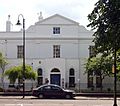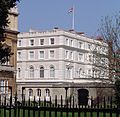Regency architecture facts for kids
Regency architecture describes a special style of buildings made in the United Kingdom. This style was popular in the early 1800s, especially when George IV was Prince Regent. The time he was Regent, from 1811 to 1820, is called the Regency era. However, the term "Regency style" is often used for buildings made a bit before or after this period too.
This style is part of the later Georgian architecture period. Georgian architecture gets its name from the four King Georges who ruled from 1714 to 1830. The Regency style is also seen in decorative arts and fashion from that time. Think of fancy furniture, striped wallpaper, and the elegant clothes worn by people like Beau Brummell (a famous fashion leader) and women in "Empire silhouette" dresses.
Regency buildings often look like the neo-classical style that came before them. But Regency architecture also started using many different "Revival" styles. This means architects looked back at older styles like Gothic, Greek, or even Indian designs for inspiration.
The early years of this style saw less building because of the Napoleonic Wars. These wars meant less money for new buildings and made materials expensive. After the big victory at the Battle of Waterloo in 1815, things changed. There was a boom in building, and most Regency architecture comes from this time.
Contents
Homes and Houses

Many Regency buildings have white painted walls, often made of stucco. Their main front doors are usually black and framed by two columns. In towns, terraced houses were very common. These are rows of houses joined together. Crescents, which are curved rows of houses, were also very popular.
You might notice fancy wrought iron balconies and curved "bow windows" on these homes. Outside of towns, detached "villa" houses were popular. These were separate homes that came in many sizes. While older Georgian homes for middle-class families were often plain, Regency homes added more decorative touches. They used classical ideas in a relaxed and confident way.
For very large country houses, architects used many different styles. The Gothic Revival style, which looked like medieval castles, became very strong. Architects like James Wyatt designed huge Gothic houses such as Ashridge and Belvoir Castle.
Some houses even looked like buildings from other parts of the world! For example, Sezincote House (1805) looks like a palace from India. The famous Brighton Pavilion (to 1822), designed by John Nash for the Prince Regent, has an Indian look on the outside. Inside, it even tried to look like a Chinese palace.
Churches and Public Buildings
Before 1818, not many churches were being built. But then the Church Building Act of 1818 provided money for new churches. Many of these early churches built in the Regency period used the Gothic Revival style. Others kept the classical look, sometimes mixing Greek or Roman ideas.
The Regency period also saw many new public buildings. In London, three bridges were built over the River Thames between 1813 and 1819: Vauxhall Bridge, Waterloo Bridge, and Southwark Bridge. These were paid for by tolls (fees to cross).
Shops also became a bigger part of new town plans. The covered shopping arcade was introduced. The Burlington Arcade in London (1815–19) was one of the first and is still famous today.
Key Architects

John Nash is the architect most famous for the Regency style. He understood what developers needed and designed many well-known Regency buildings. These include the beautiful terraces around Regent's Park and Regent Street in London. Many architects learned from Nash and spread his style.
John Soane was another important architect. He was more unique and experimented with Neoclassicism. Other architects often copied ideas from his creative buildings.
Other leading architects included Robert Smirke, who designed both classical buildings like the British Museum and Gothic ones. He worked on many public buildings. A huge project of this time was making Windsor Castle bigger for the king. This project cost a lot of money! Jeffry Wyatville won the competition to design the changes. He designed many country houses, either new or updated, in different styles.
Places to See Regency Architecture

Besides London, many other English towns have lots of Regency architecture. Some of the best examples are in new resort towns. These towns tried to be as popular as older spa towns like Bath, Somerset and Buxton.
Coastal resorts like Brighton became very fashionable. Other towns that grew a lot with Regency buildings include Royal Leamington Spa in Warwickshire, the Clifton area of Bristol, Tunbridge Wells, Newcastle upon Tyne, and Cheltenham. Cheltenham is often called "perhaps the most complete surviving Regency town" because it has so many well-preserved buildings from that time.
In Brighton and Hove in East Sussex, you can see excellent examples of Regency homes, especially in areas like Kemp Town and Brunswick (Hove).
Images for kids
-
Park Crescent, London
-
Regency houses, now municipal buildings in Cheltenham
-
The Parade, Royal Leamington Spa
-
Lansdowne Crescent, Royal Leamington Spa
-
Suburban "villa" in Edgbaston, a suburb of Birmingham, 1820s
-
Smaller semi-detached villas with Gothic details, Dawlish
-
Clarence House, designed by John Nash.
See also
- Buildings and architecture of Brighton and Hove
- Hollywood Regency








